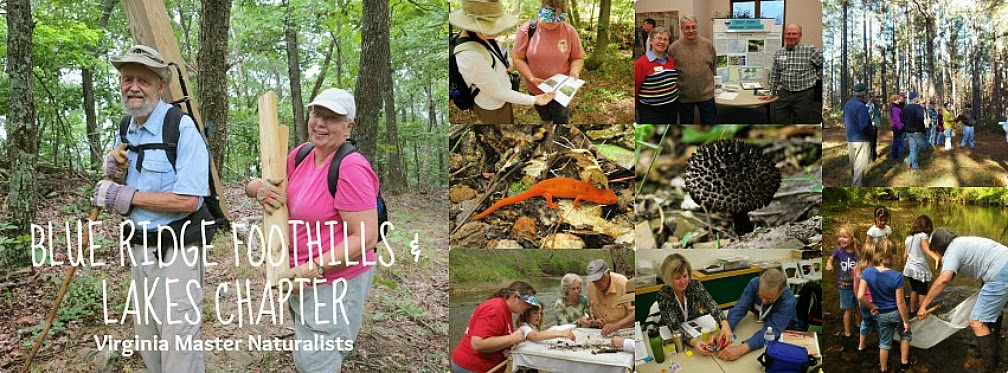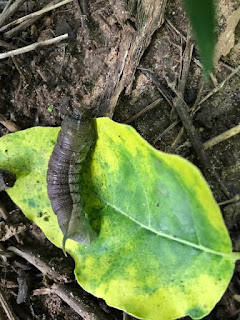Article and pictures by Beth & Paul Pautler and Charlotte Hubbard.
Beth and Paul prepare for the hunt at Mile
Marker 111.1 on the Blue Ridge Parkway.
 |
| Paul & Beth having fun searching for critters |
In
spring and summer of 2017 National Park staff and citizen scientists will
inventory land snails and millipedes along the Blue Ridge Parkway. A
national network, Hands on the Land (HOL), acts as a platform for volunteer
training and a place for data collection. HOL is supported by Partners in Resource Education, which represents
multiple federal agencies, several of which also support the Master Naturalist
program. To find out more about the inventory
and Hands on the Land, visit https://www.handsontheland.org/environmental-monitoring/land-snails-and-millipedes-transect.html
Three
BRFAL Chapter members, Paul P., Beth P. and Charlotte H. participated as
volunteer snail hunters! Slugs and millipedes were also inventoried during the
project, and we encountered many other interesting-but-not-inventoried
creatures. Beth and Charlotte attended a day-long live training held at Peaks
of Otter on May 6, that included lecture, lab and field training. Paul
completed the on-line training found on the HOL website. The background that
follows is taken from part of the volunteer training.
BACKGROUND
Land
snails are an easily overlooked and understudied part of the ecology in the
southern and central Appalachians. Of the more than 1,000 species known to
occur in North America, 25 have been identified on the Parkway, but another 125
are likely to be found here, some of which may be rare or even endemic.
Land snails, semi-slugs, and slugs contribute
significantly to decomposition and nitrification of soils through their
decaying bodies and feces. Their dead shells are a principal source of
calcium. Land snails recycle forest nutrients and are prey for a number of
vertebrate (amphibians, reptiles, birds, and mammals) and invertebrate
(insects, carnivorous snails) species. Carnivorous snails feed on
earthworms, insect larvae, and other snails. Some species consume dead and
rotting organic materials while others eat live plants, especially
seedlings and tender plants. Though poorly understood, some snails
prefer to eat fungi and may be an important factor in dispersal of fungal
spores.
Land snails are important environmental indicators and
biodiversity predictors…snails are among the most sensitive animals to
pollutants, including road runoff and acidic rainfall. Land snail populations
have dwindled in recent decades, in turn contributing to the decline of some
species of birds that feed on them and depend on them as sources of calcium for
creating egg shells. https://www.handsontheland.org/environmental-monitoring/land-snails-and-millipedes-transect.html?showall=&start=1
((Put snail photos here)) Here are some of the species we
collected on our two 2-hour sweeps of assigned GPS locations.
 |
| Each specimen was photographed in anterior, posterior and from above |
 |
| Juicy slug with orange slime! |
Millipedes: Millipedes move quite slowly and many will ball up when
threatened. Centipedes are faster and will bite if threatened, so let the
centipedes go. Millipedes have two pairs of legs on most segments while
centipedes have only a single pair of legs per segment. You will likely need
your magnifying glass to observe the millipede. Pick up the millipede and
gently coerce the millipede to open up for you. Count the body segments and on
the seventh body segment confirm the pairs of legs. If you find only one set of
legs look for the gonopods (small modified set of legs used in the reproductive
process) and if you find them, you have found a male. Upon identification, male
millipedes are dropped into a vial with alcohol for preservation. https://www.handsontheland.org/environmental-monitoring/land-snails-and-millipedes-transect.html?showall=&start=2
Found lotsa millipedes, further inspection required to determine sex

Snail
hunters have to brave areas that most naturalists have learned to avoid or
tread carefully within: Soggy ditches, rotting logs, damp leaf-litter and drainage
areas at the base of trees or rocky places. We were fortunate to avoid
encountering the scarier co-habitants of snails, although poison oak, biting
insects and “what do you think that scat is from?” kept us alert to the hazards
around us. We hope our efforts make a contribution to the inventory data. The
National Park Service can use the soon-to-be analyzed information to better
understand these residents of the Blue Ridge Parkway and what they contribute
to the biodiversity of the southern and central Appalachians.
Some other interesting stuff found:





No comments:
Post a Comment
Thanks for your comment and interest! NOW GO OUTSIDE!